Artcurial: ‘Cent portraits pour un siècle’: a sale of 18th century portraits
by The Frame Blog
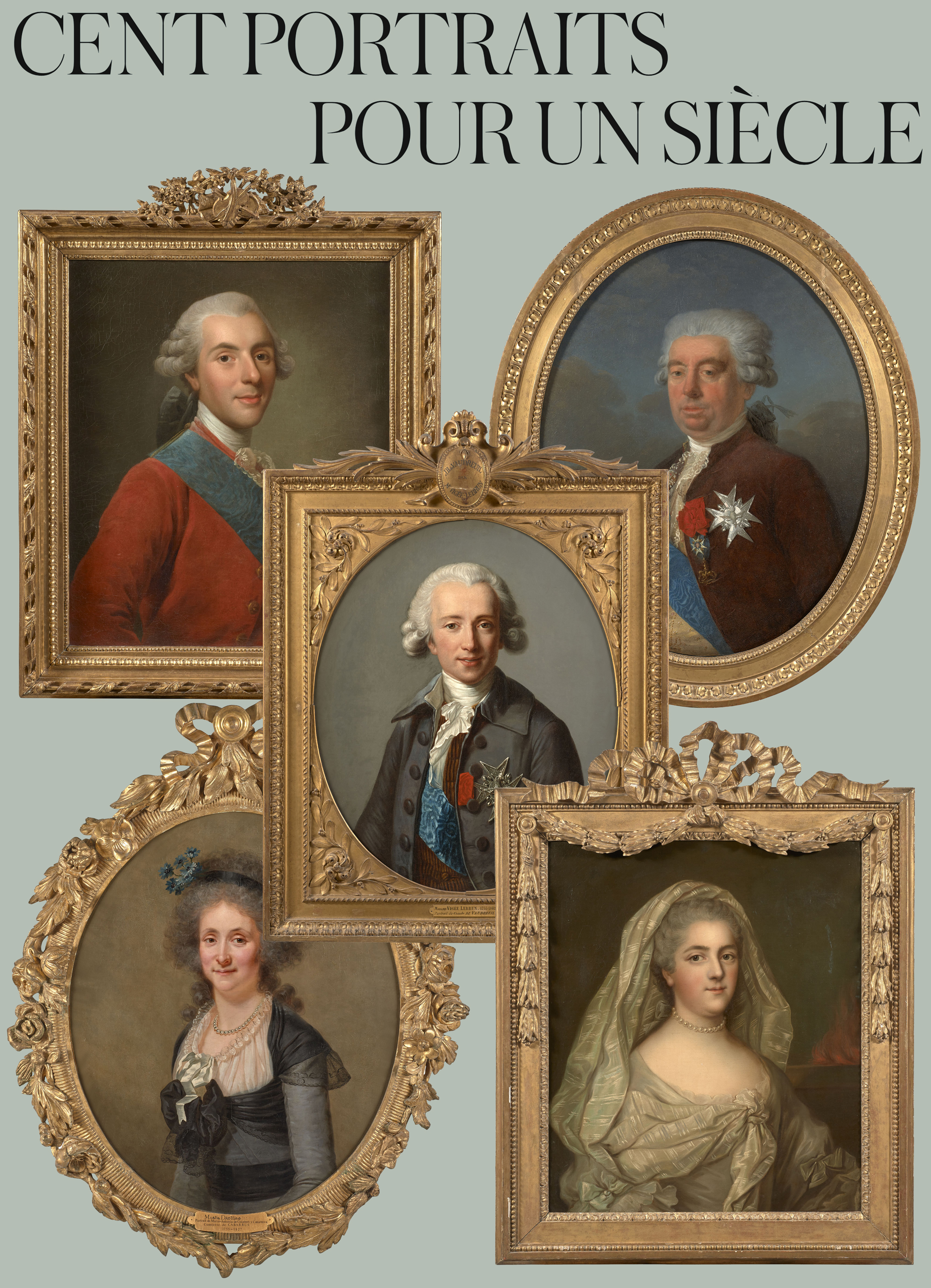
An auction, ‘One hundred portraits for a century: a Parisian collection’, will be held by Artcurial on 15th February 2022; it comprises a large and varied group of 18th century portraits, many with interesting frames – or, as the foreword in the catalogue puts it,
‘…our gallery of portraits where Louis XV, Louis XVI, Marie-Antoinette, Mesdames de France, the Dauphin and Dauphine join official and less official royal mistresses, winegrowers, painters, doctors and nuns in a complete panorama of French society in the 18th century: the century of the Enlightenment and of the ancien régime (unaware of its end), assembled over forty years…’
The Age of the Enlightenment is also the age of the NeoClassical, when there was a reaction against the flamboyance of the high Rococo style and a renewed interest in the architecture and ornament of classical Greece and Rome. Further excavations at Pompeii and Herculaneum, particularly from 1750, and the consequent foundation of the Italian Royal Academy in Naples in 1755, drew the attention of archaeologists and writers like Johann Wickelmann, whose History of ancient art and essays on the discoveries at Herculaneum were extremely influential.
The frames of the portraits in this collection (those which are illustrated in the catalogue) are all in the NeoClassical taste, many of them oval, with shallow architrave and entablature profiles for the most part and restrained bands of architectural ornament, varied by outbreaks of foliage, flowers, cartouches, trophies and madly curveting bows of pleated ribbon frontons, which spring from the crest and sometimes cascade down the sides. Three of them have been stamped with the makers’ marks of well-known framemakers. The series ends with a Greek corner frame of the 1820s-30s with plaster decoration.
Some examples are included here; for the e-catalogue see Cent portraits pour un siècle.

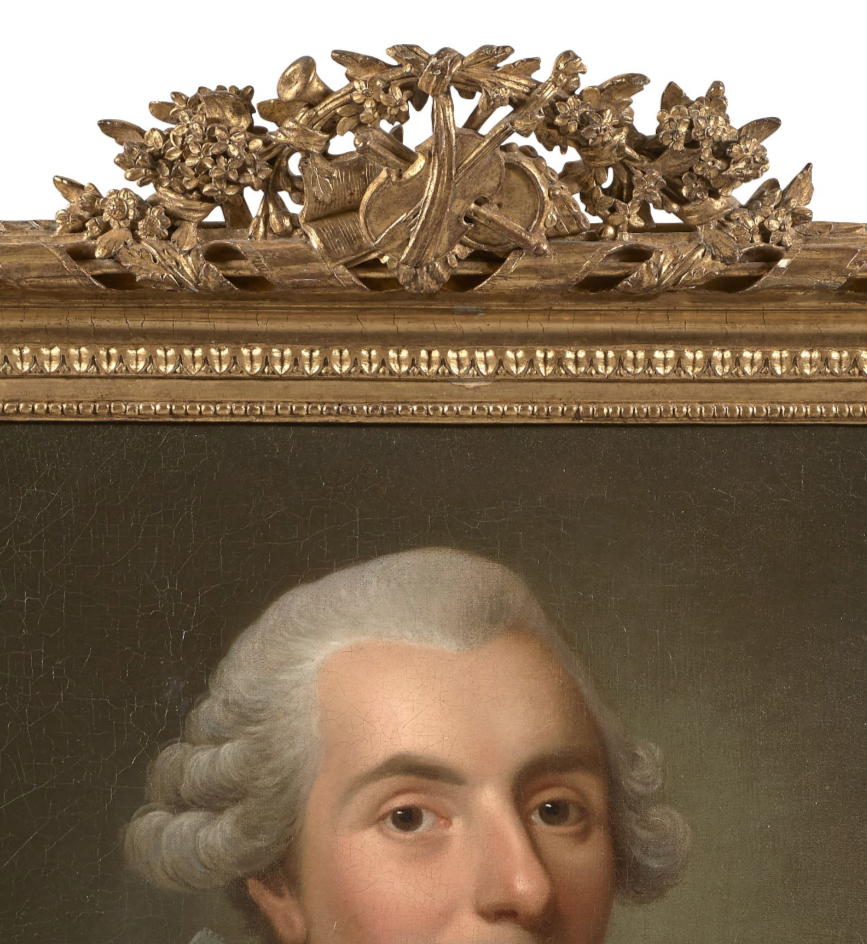 Lot 4: Jean-Martial Frédou (1710-95; after Alexandre Roslin), Dauphin de France (1729-65), 1766 onward, o/c, 65 x 54 cm., frame with entablature profile, with foliate-enriched ribbon-&-stave at the top edge; rais-de-coeur; beading at the sight edge; trophy at the crest of violin, clarinet and sheet music beneath two leafy branches bound with ribbon and decorated with bunches of sunflowers, narcissi and violets; est. €10,000-15,000
Lot 4: Jean-Martial Frédou (1710-95; after Alexandre Roslin), Dauphin de France (1729-65), 1766 onward, o/c, 65 x 54 cm., frame with entablature profile, with foliate-enriched ribbon-&-stave at the top edge; rais-de-coeur; beading at the sight edge; trophy at the crest of violin, clarinet and sheet music beneath two leafy branches bound with ribbon and decorated with bunches of sunflowers, narcissi and violets; est. €10,000-15,000
The Dauphin, son of Louis XV, died of TB in 1765, and the model for this portrait by Roslin, painted in 1764, was copied a number of times by Frédou as a memorial gift; this one is labelled ‘Duc de Penthièvre’ on the reverse. The man who would, in healthier circumstances, have ruled as Louis XVI (the rôle taken by his unfortunate son) was religious, well-read and fond of music, which has inspired the musical trophy at the crest. It is possible that this frame, like the portrait, may also have been reproduced for the various recipients, especially for those who knew him personally. The narcissus became, from the myth of Narcissus and Echo, the symbol allied to the death of a young man; the sunflower was not only a motif associated with the Dauphin’s grandfather, Louis XIV, but the flower of Apollo and particularly appropriate for a lover of the arts; violets are also emblematic of youthful death, as embodied in the legend of St Serafina [1].
As Blondel d’Azincourt suggested for the most important or central paintings in a hang,
‘Quelque fois même on fait ceintrer le haut de la bordure, ou l’on y met un ornement qui la couronne. Ce sera par exemple une guirlande qui surmonte le reste de la sculpture, ou si c’est un tableau qui représente un sujet, on y place les attributs qu’exige l’idée du peintre’ – ‘Sometimes one may even highlight the crest of the frame by setting an ornament there which crowns it. There could, for example, be a garland carved at the top, or – if it is the frame of a subject painting – one might choose trophies which express the artist’s ideas’[2].
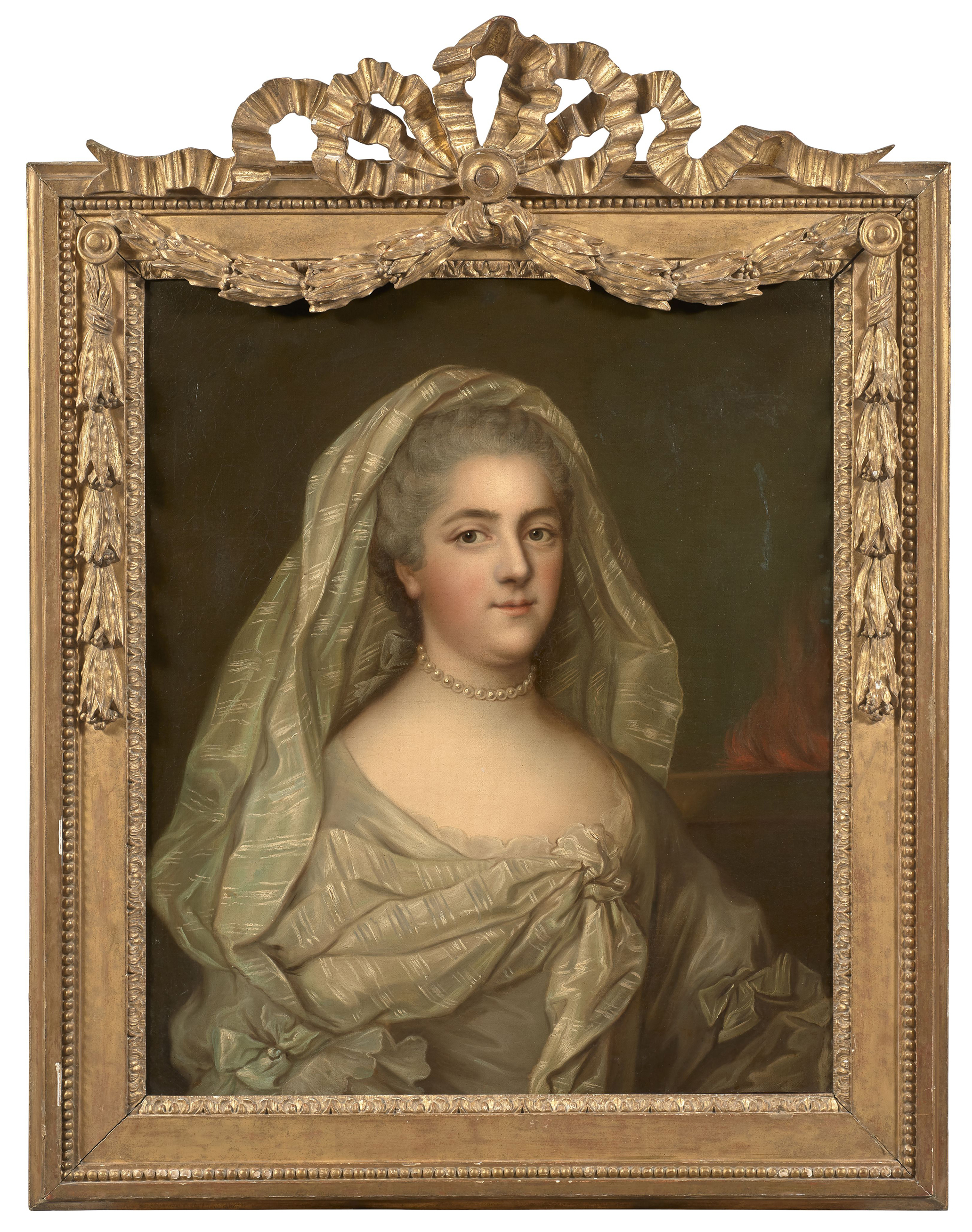

Lot 9: Anne-Baptiste Nivelon (attrib.; 1711–86: dates established by Neil Jeffares), Victoire-Louise-Marie-Thérèse de France as a vestal (Mme Victoire; 1733-99), o/c, 65 x 55 cm., architrave frame with beading below the top edge; flower-&-leaf at the sight edge; the fronton with a large bow of ribbon held to the rail by a trompe l’oeil nailhead, its knot holding a festoon of bunched bay leaves-&-berries, caught by further ‘nails’ at the upper corners of the frieze from which they depend; est. €5,000-7,000
This is one of the most attractive frames in the collection (although a later addition to this portrait). Mme Victoire was the fifth daughter of Louis XV, and sister of the Dauphin, and is represented here as a vestal virgin – a personification which is enhanced by the modified goût grec of the frame. This, the earliest, most severe and radical interpretation of the NeoClassical, was introduced in, for instance, the set of furniture (desk, cabinet and clock) commissioned by the collector Lalive de Jully, designed by the artist Le Lorrain and made around 1754-58.

Louis-Joseph le Lorrain, NeoClassical pedestals, c.1756-58, ebonized parcel-gilt wood, commissioned by Ange-Laurent de Lalive de Jully; art market
It is now in the Château de Chantilly; the pedestals (above) designed as part of the set have been sold elsewhere, and there was at least one chair, which appears in Greuze’s portrait of Lalive [3]. A feature of this rather monumental take on the antique is the use of heavy festoons of closely-imbricated bay leaves, which emerge through openings or are fixed with trompe l’oeil nailheads to corners of the various pieces. These festoons were referred to disparagingly by the detractors of the goût grec as cordes à puit or well-ropes [4], and they were gradually softened into lighter, more acceptable garlands of leaves and/or flowers (a process which seems already to have begun with the pedestals).
The bunched leaf festoons on the frames, with their breaks and frilled contours, echo the airy frivolity of the ribbon loops and swirls; the latter reflect the painted swags, swoops and knots of the gauzy stole draped around the princess, binding the whole piece into one harmonious whole. Like the Dauphin’s portrait, this is another from the hand of a copyist, and the catalogue entry indicates that the costume was an invention of the latter; it has evidently inspired the later reframing.
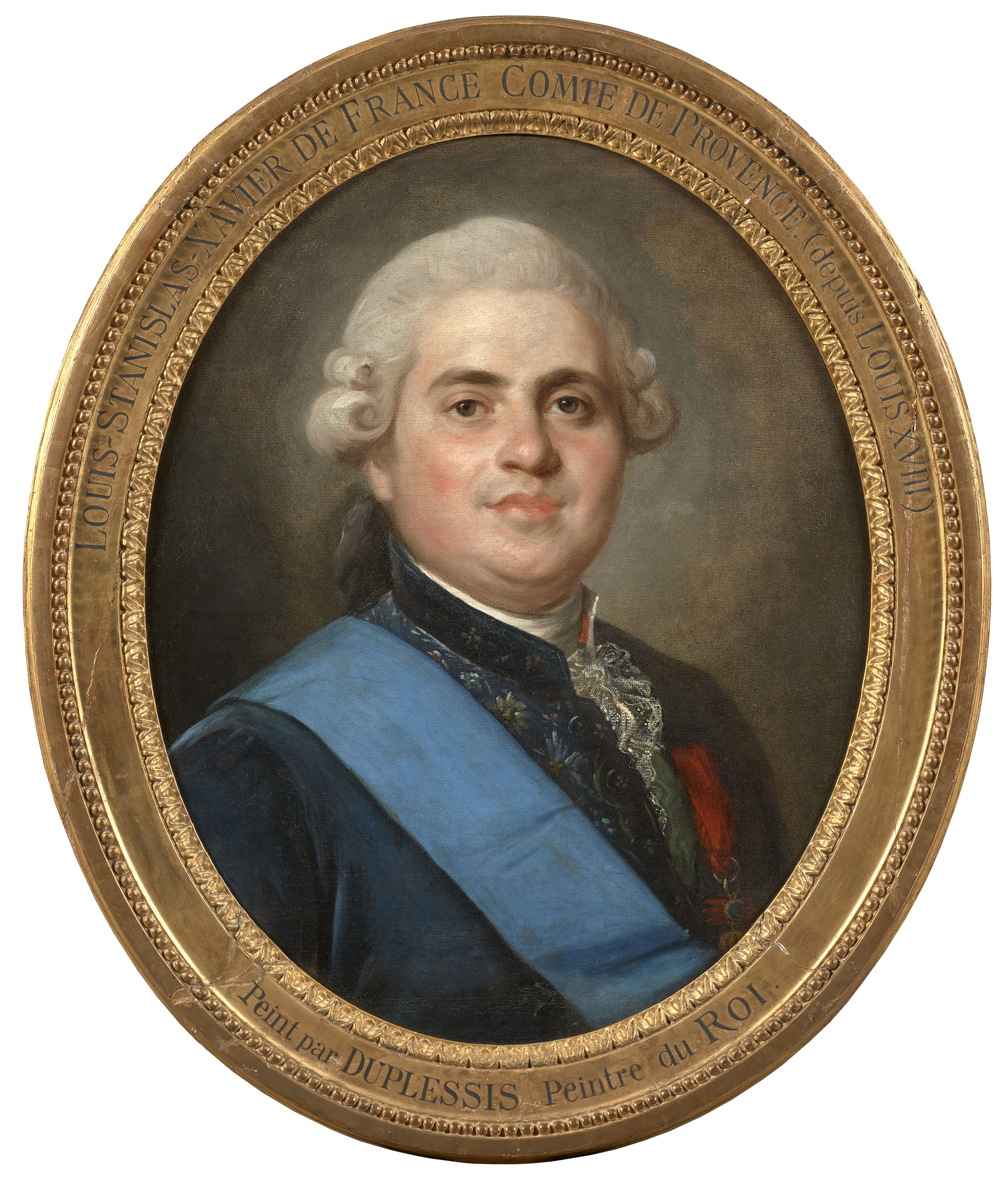

Lot 14: Joseph-Siffred Duplessis (1725-1802), Louis-Stanislas-Xavier de France, comte de Provence (1755-1824), o/c, 58 x 47.5 cm., architrave frame with slightly canted profile; beading below the top edge; leaf-&-tongue at sight edge; inscribed with the name of sitter and artist; est. €20,000-30,000
This is a study from the life for the official portrait now in the Château de Chantilly, and for at least one other portrait, differently costumed. The frame on the present portrait may be the artist’s choice as the souvenir of a royal commission, perhaps however with a later inscription; its classical tension of frieze and ornament is the perfect foil for the Comte’s florid presence – a much better match, in fact, than the completely plain but more meretricious appearance of the Chantilly frame.


Lot 30: Josef Johann Melchior Wyrsch (1732-98), Le Maréchal Guy Michel de Durfort, duc de Lorges et de Randan (1704-73), 72 x 60.5 cm., frame with entablature profile, with a slightly enlarged order of rais-de-coeur below the top edge; beading at the sight edge; est. €10,000-15,000
Another attractive frame; it’s a pity that the corners are less than immaculate and suggest that it may have been cut down to frame this portrait, but it is highly suitable, giving a shimmering border, and an optical pull into the space where the Maréchal stands.


Lot 36: Elisabeth Louise Vigée Le Brun (attrib.;1755-1842), Alexandre Marie Léonor de Saint-Mauris, prince de Montbarey (1732-96), o/c, 81 x 65 cm., frame with entablature profile, with enriched back edge; acanthus-&-shield below the top edge; rais-de-coeur at the sight edge; est. €30,000-50,000
A version – made for her oil paintings – of the oval architrave frame used by Vigée Le Brun for her pastels in the 1770s [5], this example is identical in its composition, if not in its execution, to the frame on the Portrait of Mme Jacques-Francois Le Sèvre of c.1774-78, and (with auxiliary ribbon fronton) of Mme Grand (1783; below).

Elisabeth Louise Vigée Le Brun (1755-1842), Mme Grand, 1783, o/c, 92.1 x 72.4 cm., Metropolitan Museum, New York
In these pared-back, classicizing frames with their simple profiles, the use even of a narrow band of the more complex acanthus leaf with its rhythmically overlapping leaves, slightly undercut around the contours, gives an impression of comparative richness. It contains and reinforces the tension within the prince’s portrait of the austere background and static pose against the embellished costume with its embroidery, orders and lace. However, with an additional outer moulding, a royal trophy at the crest, and festoons of tumbling flowers, the restraint of this classical model becomes the powerful and opulent setting for a portrait of Louis XVI, after Duplessis.
Vigée Le Brun’s pastel portrait of the same sitter dates from 1779, and has its original frame, with piastre-&-rosette moulding at the top edge, burnished hollow, beading and rais-de-coeur [6].


Lot 37: Elisabeth Louise Vigée Le Brun (and workshop; 1755-1842), Louis Hercule Timoléon, duc de Cossé (1734-92), o/c, 55.5 x 45.5 cm., frame with entablature profile, with prominent spiral leaf-&-stave below the top edge; acanthus-&-shield sight edge; est. €20,000-30,000
This frame has evidently been cut down from some larger version (on the long left-hand rail the spiral leaf is centred, but not on any of the other three rails; it runs from the bottom left-hand corner to the top right, but also from the top left to the top right). However, it provides a handsome ornamental border for this replica: one of several which copy an original pastel by Vigée Le Brun at the Château de Brissac, home of the duc. The latter has its original frame, similar to the pastel frame mentioned above (Lot 36).


Lot 39: Elisabeth Louise Vigée-Lebrun (1755-1842), Joseph Hyacinthe François de Paule de Rigaud, comte de Vaudreuil (1740-1817), o/c, 72.5 x 59 cm., frame with entablature profile, with acanthus ogee below the top edge; spiral ribbon at the sight; spandrels with foliate bosses with a whorl of bay leaf-&-berry sprigs; the fronton with palm branches supporting a scrolling inscribed cartouche with imbricated coin and floret mouldings; est. €50,000-70,000
Another especially attractive frame, by a maître sculpteur working for the Bâtiments du roi, this may perhaps be by Jean Chérin (1733/34-85, maître sculpteur 1760; or his son, Jean Marie Chérin, fl. 1770s-post 1806, maître-menuisier 1779), some of whose frames seem to have been paired (either originally or by later owners) with other works by Vigée Le Brun [7]; Neil Jeffares (see below, lot 59) also suggests Levert might have produced frames for her in the 1770s and 1780s.

Louis XVI frame, c.1775-85, sight size 124 x 82 cm., width 15 cm., detail; collection Paul Mitchell
The handling of the acanthus leaf ogee and the spiral ribbon is close to that of a Chérinesque Louis XVI frame with acanthus hollow in the collection of Paul Mitchell, whilst the small smooth bay leaves, whorled in the spandrels of the Comte’s frame, are reminiscent of the sprays of similar leaves carved as rinceaux between the corners and centres of Chérin’s transitional style frames [8]. Similarly, the palm branches carved at the crest and the cartouche bearing the names of artist and sitter have much in common with the fronton on the greatly enriched frame of Vigée Le Brun’s 1785 Marie Antoinette and her children at Versailles (unknown maker).
Whoever the carver might have been, there is a particularly satisfying harmony and balance in the junction of frame and portrait; like the frame of Lot 9, the portrait of Mme Victoire, the frame of Lot 39 is perfectly proportioned and decoratively attuned to the painting it holds.
The Comte commissioned at least six images of himself from Vigée Le Brun; a replica of this portrait in oils in the Musée Jacquemart-André has a version of the frame used frequently for her oval pastel portraits .


Lot 52: Rosalba Carriera (attrib.;1673-1757), L’apothicaire Antoine-René Poullain (1698-1779), pastel on paper, 53.5 x 42.5 cm., frame with an ogee profile, with sanded frieze; acanthus-&-flower on a hatched ground at sight edge; est. €8,000-12,000
This is a French pastel frame from the second quarter of the 18th century, in a slender variant perhaps due to the cropped space of the composition. It seems intended more for a close-framed drawing than a pastel, given its place amongst other more robust frames in this collection, but it reflects the delicacy of the portrait, and recalls the fact that Rosalba’s Venetian pastels have quite slim Rococo panel frames. The style is a straight-sided version of the Louis XV ogee frame, which was versatile enough to be used (in different proportions) for oil paintings, watercolours, drawings, and pastels, as well as for an inner mouldings within more elaborate Rococo boiseries.


Lot 59: Etienne Aubry (1745-81), possibly Suzanne Necker, née Curchod (1737-94), o/c, 60 x 48.5 cm, carved and regilded frame with stamp of A. LEVERT, entablature profile with canted top edge; acanthus-&-leaf bud ogee; beading at the sight edge; est. €5,000-7,000
This frame cannot be the original; it has been fitted to a rather smaller portrait than it was made for, with a badly cut inlay of what looks like gold-painted metal or possibly card. This is a shame, given that it has the stamp of Levert and that the ornamental run of acanthus-&-leaf bud is so meticulously carved, so fluid and so handsome. It would be entirely suitable for the (possible) wife of a Swiss financier and minister and the mother of Mme de Staël, if only she were large enough; as it is, it looks too wide and almost ungainly for the painting it contains.
Neil Jeffares has researched Levert (Honoré-Antoine; c.1710-d.85), and produced a splendid and detailed biography which includes the parish where he lived and worked in Paris, his marriage and guardianship of his cousin’s children, his parallel work as a cabinetmaker or ébéniste, his belated registration as a maître in 1774 (probably because of his parish having been excused from the rules of the guild system by the king), and a number of illustrations of his frames [9]. This current example is a beautifully decorative addition to that number – but it needs a bigger woman to fill it.


Lot 64: Jean-François Marie Bellier (1745-1836), Portrait of a woman in a rose-coloured frock, original o/c, 55 x 46 cm, entablature frame with rope moulding at the back edge; enriched floral chain at the top edge, fluted hollow; beading; rais-de-coeur at sight edge; est. €2,000-3,000
A fluted hollow was a another enrichment of the NeoClassical entablature frame; stamped examples survive of fluted frames by Etienne-Louis Infroit (see below) and Claude Pépin (fl. 1770s, maître-menuisier 1775) amongst others, and in both oval and rectilinear forms. The oval frame of lot 64 is close to the rectangular fronton frame on Vigée Le Brun’s Comtesse de la Châtre of 1789, save for the guilloche on the top edge of the latter and acanthus sight; see also her Jeune fille en rosière of 1777, with plain top edge and ribbon and festoon fronton. The regular rayed effect of fluting around an oval contour creates an enhanced sense of recession into the space of the painting, and perhaps a greater feeling of volume in a portrait; however, compared with earlier examples from this collection, the four orders of ornament may seem comparatively busy for a painting where the image fills the whole vertical space, and where the costume is already a rich confection of ornament.
The floral chain at the top edge is made of plaster, pressed in a mould and applied to the otherwise carved frame before gilding. At this point in the 18th century plaster and compo were still mainly accessories to the art of the sculpteur, although there had been a court case over the use of compo as early as 1722-23, over moulded frames made by André Tramblin and his son-in-law Pierre Delaunay which had been sold as carved wood. The court decided in favour of ouvrages de composition, provided that they were so labelled, and the powerful Académie de St Luc voted for their use by its members. This vote was rescinded in 1727, but a breach in the opposition of the guilds had been made, and Delaunay’s frames with composition ornament were openly recommended from the mid-18th century.

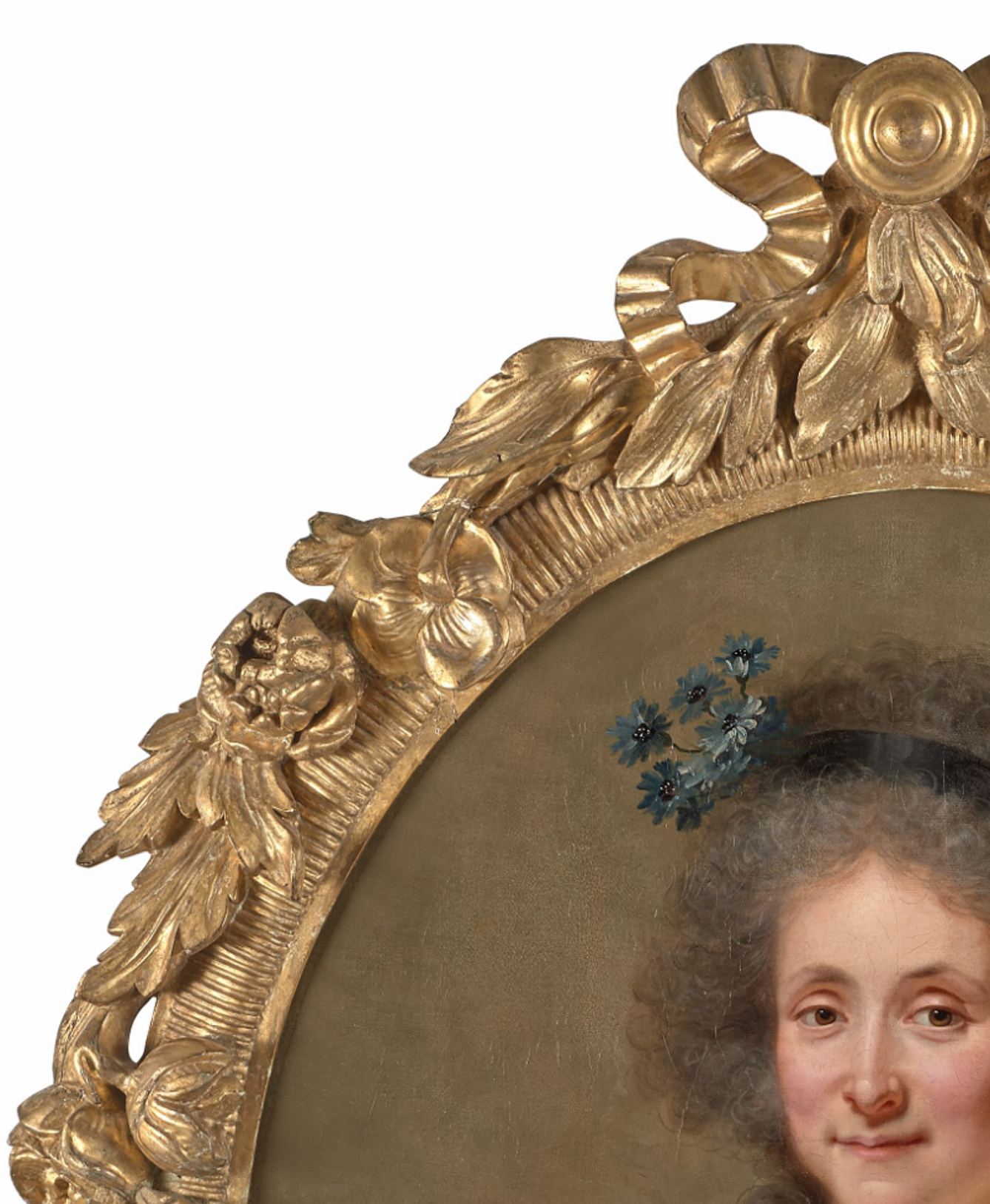
Lot 79: Martin Drölling (1752-1817), Maria Antonia Galabert y Casanova, comtesse de Cabarrús (1755-1827), o/c, 72.5 x 59 cm, frame with shallow concave profile, fluted overall; with a ribbon-tied trompe l’oeil nailhead at the crest from which depend two rose branches with leaves and blooms around the contour; est. €7,000-10,000
This portrait probably shares with one of its replicas the date of 1789 (see catalogue entry), when the sitter visited Paris and was married to the Spanish financier, Francisco Cabarrús Lalanne, but the frame may well have been made later, when the Comtesse had returned to Spain. It is therefore likely to be of Spanish workmanship, which would explain the fluted hollow comprising the whole façade of the main structure and the slightly coarse carving of the rose branches which cascade from top to bottom. The NeoClassical style had taken hold in Spain from the mid-1780s, in reaction to the long-enduring phases of the Baroque; however, the original restraint of NeoClassicism was soon overlaid with decorative details, and the festoon of large leaves and blowsy roses may be an enthusiastic response to the ribbon and flower festoons of French portrait frames: for example, Vigée Le Brun’s Jeune fille en rosière mentioned above.


Lot 81: Louis-Michel van Loo (1707-71), François Louis Colins (1699-1760; Keeper of the King’s Pictures), c. 1755, o/c, 64.5 x 55 cm, carved and regilded Louis XV ogee frame with stamp of INFROIT and JME (Jures-menuisiers-ébénistes); est. €10,000-15,000
Etienne-Louis Infroit (1719/20-95 [10]) was registered as maître-sculpteur in 1759, but due to the inequality of protection between the Académie de St Luc, alma mater of carvers, and the guild of menuisiers-ébénistes or joiners and cabinetmakers, he was also forced to register as a master with the latter in 1768, in order to be able to make the wooden carcasses of his frames as well as to carve them. The double registration held for his son, Claude Infroit (1752-1817), who was accepted as maître by both bodies in 1777 [11]. This means that this frame must date from 1768 or later, and cannot be original to the painting; it is also slightly old-fashioned for its time – although the plain Louis XV ogee frame had (like so many styles) a much longer life than its name might suggest, and is very suitable for a male portrait of 1755.
The Infroits seem to have run a thriving workshop, which produced numerous contemporary styles from NeoClassical oval frames of a spare simplicity to the most opulent of trophy frames. An example bearing the stamp of Claude Infroit – which must have been executed for a betrothal or marriage portrait – has an extraordinarily large and densely-composed fronton of trophies associated with love: turtle doves, a bow and quiver of arrows, a flaming torch, festoons and wreaths of roses and other flowers amongst branches of olive and myrtle leaves.


Lot 96: Elisabeth Louise Vigée-Le Brun (1755-1842), Adrienne Godard d’Aucour de Plancy (1754-82), original o/c, 64.5 x 50 cm, original carved giltwood architrave frame with stamp of H. LETONNE and JME, with slightly canted profile; beading below the top edge; leaf ornament on a hatched ground at sight edge; est. €30,000-40,000
Henri Létonné (fl. 1760-91) was another member of the guild of menuisiers-ébénistes, although he seems not to have become a double maître like the Infroits.

François Boucher (1703-70), Shepherd & shepherdess reposing, 1761, o/c, 117 x 85.5 cm., Wallace Collection
There is a frame with his stamp in the Wallace Collection, on Boucher’s Shepherd and shepherdess reposing of 1761, a later reframing of the painting. It is a restrained architrave with a large scrolling cartouche and bay leaf wreath fronton, with branches of acanthus and bay leaves. None of this seems to have much symbolically to do with Boucher’s sentimental pastoral, and the frame may have been designed for a portrait of someone who deserved so many bay leaves.
By the time that Vigée Le Brun’s portrait was painted in the early 1770s, Létonné would have been registered as a maître, and since the painting seems to have spent most of its life at the Château de Plancy, this is almost certainly the original frame. In its current pairing the leaf ornament on textured ground at the sight edge produces a sparkling ribbon of light, animating what is a charming and golden image.


Lot 100: Louis Hersent (1777-1860), Cardinal Anne-Antoine-Jules de Clermont-Tonnerre (1749-1830), original o/c, 72 x 59 cm, Greek corner Restauration frame with ogee profile, with palmette and scrollwork corners; with antique palmette, acorn, floral and foliate motifs centred on sunflower paterae; with a flower-centred double-scrolling heart-shaped motif in the frieze; leaf ornament at the sight edge; est. €4,000-6,000
The portrait is a replica by the artist of a first portrait (dated 1825) painted after the sitter’s institution as cardinal; the frame is a blend of the Empire style diffused through the designs of Napoleon’s architects, Percier and Fontaine, and the later Restauration style of the 1820s and 1830s.

Jacques-Louis David (1748-1825), Pope Pius VII, 1805, Musée du Louvre. Photo: Sailko
An example of the former is the frame of one of the three portraits painted by David of Pope Pius VII in 1805, and what this combination of portrait and frame must be seeking to evoke. David’s portraits are mainly in Empire frames, probably in symbolic rejection of the styles fashionable during the ancien régime as much for their decorative qualities – although the vast percentage of frame ornament was from this time made of composition or plaster, so there was added economy in the choice.
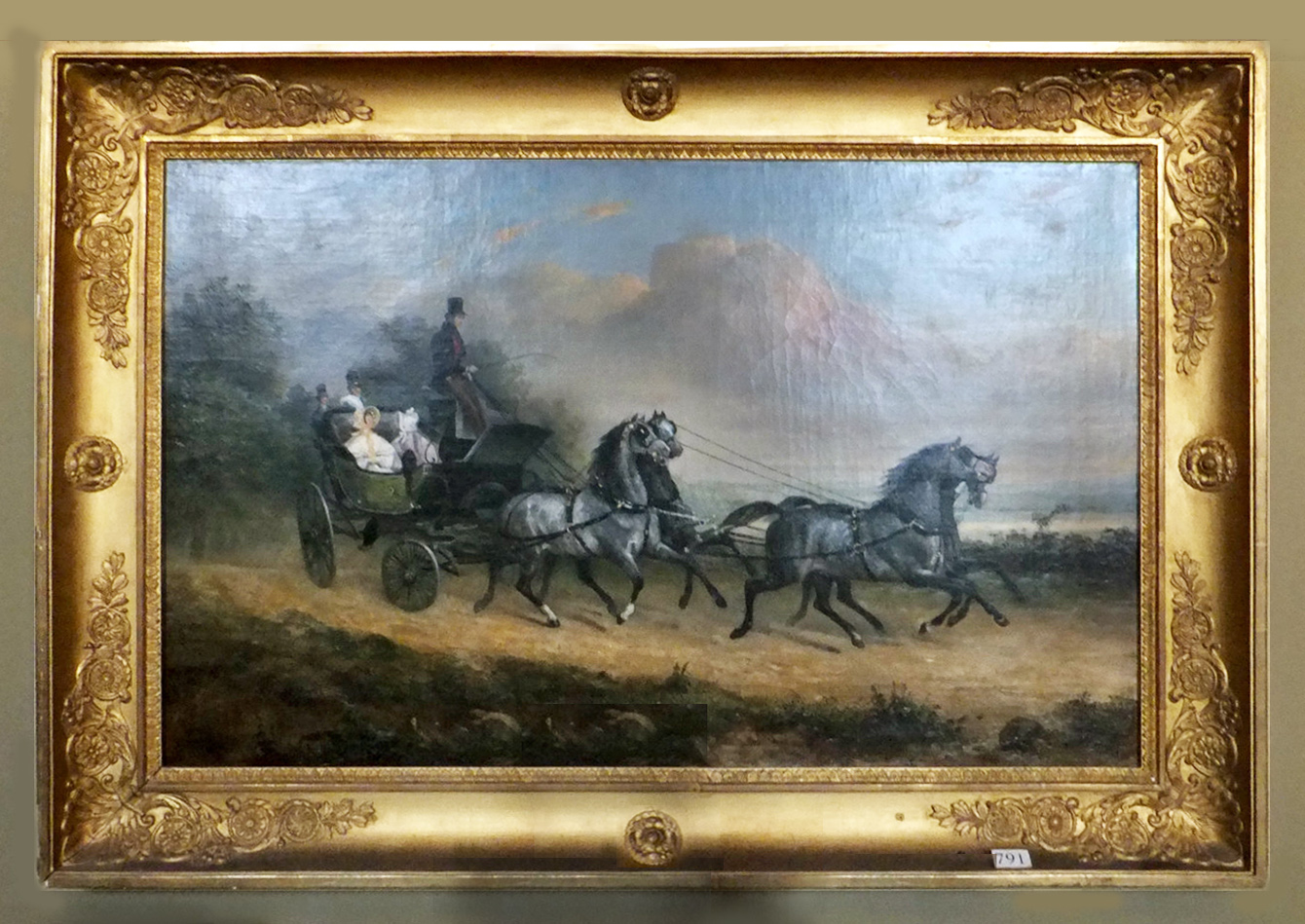
Horace Vernet (1789-1863), The barouche, 1836, Musée Nissim Camondo, Paris
The Greek corner frame on Vernet’s The barouche is an example of an original Empire frame of the 1830s. It has a wide concave profile, and comparison with the frame of Hersent’s Cardinal demonstrates that this style of ornament was never intended for an ogee, which distorts the ends of the corner scrolls as they extend along the rail, making them appear to have been cut along the top. It is difficult to understand the reason for such a strange dislocation of visual effect, unless the scrollwork and central motifs have been added to the existing palmette corners at a later date. The frame as it stands certainly gives a David-like aura to the portrait; there can have been no intention at the time to link it to the Napoleonic era, since the Cardinal was one of the officiating priests at the coronation of Charles X.
********************************************
With thanks to Neil Jeffares for corrections in dates, spellings, and attributions; and to Ólafur Þorvaldsson for information on the reframing of Anne-Baptiste Nivelon’s Mme Victoire.
********************************************
[1] St Serafina died, like the Dauphin, after an illness; she spent the fifteen years of her life doing good deeds, and violets are supposed to have grown from her deathbed.
[2] Barthélémy Augustin Blondel d’Azincourt (1719-94), ‘La Première Idée de la curiosité, où l’on trouve l’arrangement, la composition d’un cabinet, les noms des meilleurs peintres flamands et leur genre de travail’, Institut d’Art et d’Archéologie, Université de Paris, IV, MS 34, fol.1-12, published as the Appendix to Colin Bailey, ‘Conventions of the 18th century cabinet de tableaux: Blondel d’Azincourt’s La Première Idée de la curiosité”, The Art Bulletin, vol.69, no 3, Sept., 1987, p.446
[3] Simon Jervis, ‘Two unknown suites of early NeoClassical designs’, Burlington Magazine, vol. 126, no 975, June 1984, pp. 342-47
[4] Charles-Nicolas Cochin, on Lalive de Jully’s set of furniture
[5] See Neil Jeffares, ‘Elisabeth Vigée Le Brun: Part II: her pastel frames, 1772-1789’
[6] Ibid.
[7] Suzanne Smeaton & The Frame Blog, ‘ Elisabeth Louise Vigée Le Brun: Part I: a review of the 2015-2016 exhibition, with a general note on some frames’
[8] Paul Mitchell, ‘A signed frame by Jean Chérin’
[9] See Neil Jeffares, ‘Antoine Levert, maître menuisier-ébéniste‘
[10] Edgar Harden, ‘Identifying the framemakers of 18th century Paris’, National Portrait Gallery website
[11] Neil Jeffares has produced a useful family tree for the Infroits in his Dictionary of pastellists before 1800

Dear (magic) Lynn,
Many thanks for your new brilliant article. Excellence is your nature.
Concerning the footnote 10 about Edgar Harden’s article « Identifying the Framemakers of 18th century Paris », two others framemakers must be added to the list of 22 framemakers made out by Harden:
Louis Boussard, ‘maître’ in 1762, and Jean-Baptiste Detroulleau, ‘maître’ in 1767. The first stamp was on the NeoClassical oval frame nr. 257 from the 14 February 2017 Artcurial frame sale. I discovered by chance the second one (with ‘JME’) two months later on a small NeoClassical fluted frame, which framed an early 20thC painting, from an everyday sale at Drouot’s, Paris.
Very best wishes,
Bruno Hochart
LikeLike
Dear Bruno –
How lovely to hear from you, and what a very kind comment! And also – how interesting that you have discovered TWO more framemakers with estampilles. Perhaps I should copy Edgar’s list, and add those to the end of the piece, so that they are all together…? – I think that I must have the link to the sale for the first one. Might you perhaps have images of the frames and their stamps? I will of course credit all of this, as you know…
V. best wishes,
Lynn
LikeLike